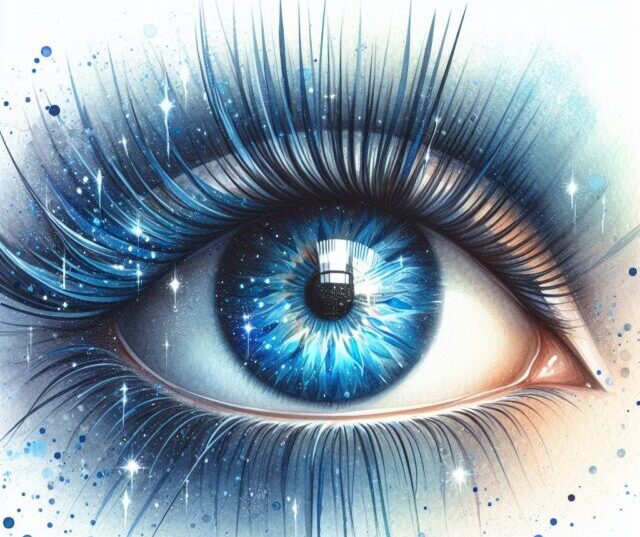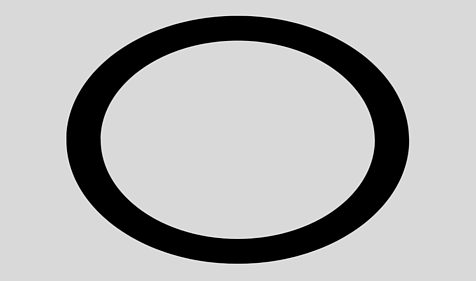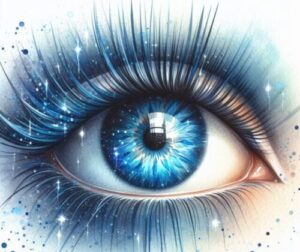
Protecting and enhancing your vision is important as you spend countless hours looking at device screens. After all, they are the ‘windows of your soul.’ If you’re working from home, this is an excellent opportunity to care for your precious eyes like never before.
So, what is the most mindful way to care for your eyes?
“Soon after we can see, we are aware that we can also be seen. The eye of the other combines with our own eye to make it fully credible that we are part of the visible world.”
Ways of Seeing by John Berger, p9
We are always looking outside
The visual sense is dominant in most humans today because of the immense visual stimulation surrounding us. Sadly, listening has taken a back seat, but you can read about mindfulness and Ear Care here.
We spend a considerable part of our daily lives looking out into the world via media, the internet, social interaction, etc. We do this because we are persuasively encouraged to play our role in our global and local communities and often are afraid of missing out and being left behind if we don’t.
However, continually looking outside throws our perceptions out of balance, separating us from ourselves. Take the Internet, with its colours, countless pages of images and advertisements, and much more. We make millions of choices and comparisons every moment we browse the Internet. This can be overwhelming, so spending the minimum amount of time browsing is advisable to rest your intellectual mind.
When working from home or in a traditional office, cultivate Mindfulness and Eye Care by working offline in an environment of your choice whenever possible. Take your laptop to a park or sit in a garden, moving away from your workstation or desk.
Duality is a strong factor in Mindful Eye Care
We intuitively know there is another aspect of our being we have lost touch with, and we know it leads to duality: us and them, out and in, absent and present and so on. Therefore, we must move away from the external pull outside and go inside using Mindful Practices. When mindful, we use our senses more equally instead of overusing the visual sense.
Mindful vision can be conscious with no beginning or end, even when you are sleeping. Eye Care entails exploring your unconscious mind by turning 365 degrees and looking inside to reconnect with your heart. This gazing inside is one of the many functions of seeing. Watching inside is the basis of meditation to develop the skills of watching how our wild minds and no-minds work.
Mindful Seeing Promotes Deeply Knowing Ourselves
We need to know ourselves before we can honestly know others, and they know us. We must see ourselves and be able to see and remember our own faces. If you close your eyes, can you remember your own face? We easily forget if we are constantly directing our attention outwards.
Our motivation for looking outside needs to be examined, too. Maybe we are looking for fame and wealth, solutions, answers to questions, and love. Love starts with loving ourselves so our spiritual container can expand to love and trust others fully. This starts with truly seeing ourselves alone in the invisible world.
“Love is watching ourselves and others without judging or desiring to change.”
John Berger
We are perfect just as we are inside, though external influences lead us to believe we will never be good enough. Mindful Eye Care allows you to accept exactly who you can see yourself to be.
Gaze at the circle and say the words below it repeatedly.

I am perfect just as I am.
Check occasionally to see if you can remember your face. When you look inside, if you glimpse your face, it is said that this is your eternal face, which social conditioning and conforming cover over. The Maoris, the indigenous people of New Zealand, carve their eternal faces on trees so that they can always remember them. This is your true nature.
Eye Visualisation
- Stand in front of your workstation.
- Lengthen your spine with the mere thought of an elegant, long spine and neck.
- Widen across the lower rib cage as you inhale and exhale the air you borrowed from the Earth.
- Visualise your heels going down into the Earth while the crown of your head goes up into the infinite blue sky.
When you are ready, please blink 20-30 times. This cleans the eyes and stimulates the optic nerve.
Let go of the focus of your Eyes
When caring for your eyes mindfully and looking outside, change your focus often while intensely viewing your screen. Look at the screen, then look above it or to the side. Look into the distance, above, to the side, every few minutes. Keep your eyes moving instead of staring for too long. This will keep your eyes moist and your field of vision clear. Also, think of your eyes being wide apart to help soften the surrounding tissue, which is very sensitive. Softness around the eyes will change the tension in y our whole face.
Your peripheral vision is vital, too. Notice how far to each side of your body you are aware of without moving your eyes. Let go of the limiting focus of your eyes on screens and allow it to become vast. In reality, there is no difference between you and infinite reality. Only the ego convinces you that you are separate. The thin membrane of your skin is the only separation.
With these insights into seeing, you may glimpse just being – nothing else, no thoughts or feelings to register and interpret.
Old Habits Interfering
Tour mind may interfere occasionally, prodding you and trying to talk you out of becoming vast and connecting with your true nature. If and when this happens, see each interference as:
“a snowflake falling on a hot stove”
Watch each thought or judgement melt and evaporate from your new, vast perspective.
Indigenous People and Visual Acuity
To help inspire you about your eye care, the people in the world who have the best vision are the indigenous people living traditionally in the interior of Australia. They can see accurately four times further than developed people: 6.8 instead of 1.4 metres.
They still live close to the land and need excellent vision to survive. Those of us who stay inside in polluted cities for so much of our days have comparatively poor and limited vision. Experts say that Australian aboriginal brains are wired differently because they struggle to survive in one of the harshest environments on Earth.
I have personal experience of this. I lived with a group of Aboriginals who were leaving the settlements provided by white Australians to return to traditional life deep in Arnhem Land, in the very centre of the continent.
One day, the women took me hunting with them. One of them was using a boomerang, and she soon spotted a fully mature emu that I couldn’t begin to see. Then, squatting and standing up like lightning, she launched her boomerang decorated with her Emu totem marking in the opposite direction to her prey. Seconds later, after the whirring circular motion was complete, the boomerang struck the emu and killed it outright. The huge bird did not attempt to flee, so it didn’t suffer any unnecessary pain. It was an incredible feat performed as a result of her visual acuity.
Practical Tips for Mindful Eye Care
Be careful to ensure the following in your workspace:
- good lighting
- natural light
- air circulation
Research shows that the Aboriginal diet includes large amounts of Zinc. So you can improve your eye health by eating green vegetables every day, plus plenty of eggs, oranges, corn, purple berries, strawberries and raw garlic.
I make a green leafy smoothie every lunchtime, adding as many zin-rich ingredients as possible. As a result, even though I sit in front of a screen for an average of 5 hours every day, I no longer depend on glasses.
We should spend some time outdoors every day. Sit in the garden or balcony, close your eyes, and look up at the sun. Direct sunlight allows our bodies to create Vitamin D, which helps to strengthen eyes.
After 10 minutes of sunlight, cup your palms over your eyes or use a black mask to see perfect blackness. This will allow the eyes to rest. The colour you see may not be entirely black, but accept whatever colour it is (ranging from navy blue to dark brown). But it may help to try to imagine the richest of back velvet. This warms the tissues around the eyes and helps the related muscles soften.
Watching Meditations
There are many meditations to cultivate watchfulness, but I will introduce those later. For mindful practices to protect and enhance your eyes, please ponder what it would be like to witness every single moment of your existence.
For short periods of mindful time, do nothing mechanically or unconsciously. Hold on tight to your full awareness.
See like a baby does, without the intellectual function of criticism, comparison or judgment. Before being socially and culturally conditioned, a baby is fully conscious. It doesn’t yet know how to look with its mind. This blissful state is what we can reach by meditating. It is pure freedom, but it doesn’t come overnight. Start with mindfulness.
Your eyes and reading and writing
It may surprise you that there is a strong connection between the eye and the voice. While working with text, reading aloud can update the brain if you are tired or not thinking clearly.
Reading aloud involves working the memory. If you have reading to do, read it aloud standing at your desk, looking away from the screen beyond the screen and back to your screen while memorising short chunks of text. It also helps to imagine you are reading to someone else.
When I have finished writing something, I always read it aloud into an audio file, then play it back and listen to it. The act of reading what you have written so carefully out into the air indicates the places that don’t flow smoothly or may have grammatical flaws, etc. The other option is to make a video or audio track to accompany your writing when it is published. This is very fashionable as people are busy but want to stay in touch with developments, etc. For example, they can listen to your post while driving or cooking and give their eyes a well-earned rest.
Final Thought
Watchfulness is the most critical function of the eyes. It preserves mental health and happiness and opens the path to connecting with True Nature.
The world would be different if all global community members were better connected with their True Natures.

Image: ‘Owl Flying Through an Orchard’ by Mariko Kinoshita.


As someone who spends a lot of time in front of screens for work, I’ve noticed increased eye strain and fatigue lately. This article made me realize the importance of mindfulness in eye care. Incorporating these mindfulness practices into my daily routine, especially the 20-20-20 rule, has made a noticeable difference. Does anyone have additional tips for reducing digital eye strain?
Wow, what a comprehensive article, thank you for sharing your vast knowledge of mindfulness and eye care.
As I read your article I tested out the tips you were giving and will aim to make that a daily practice when I’m working at my laptop from now on. I have my laptop set up at a window where I can see the ocean so it’s only a pleasure and look up from the screen. This morning I can see a ship and tug in view, calling me to do my morning beach walk with the dogs.
I love that you included looking inside and connecting to the heart as this is a practice I also like to do daily.
Thanks for your inspiration, keep shining your special light in the world.
Lauren,
How lovely. So glad this resonated and that your eye health is safe. Your ocean view and ozone sounds heavenly.
Your light dazzles too. So open and friction-free.
Blessings and expansion.🪷